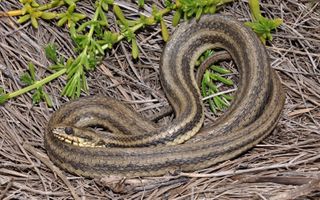Atlantic salt marsh snake: Difference between revisions
mNo edit summary |
m (→References) |
||
| Line 42: | Line 42: | ||
==References== | ==References== | ||
<references> | <references> | ||
<ref name="USFWSdetermination1977">[https://www.govinfo.gov/content/pkg/FR-1977-11-29/pdf/FR-1977-11-29.pdf#page=35 Federal Register | <ref name="USFWSdetermination1977">[https://www.govinfo.gov/content/pkg/FR-1977-11-29/pdf/FR-1977-11-29.pdf#page=35 Federal Register - USFWS - Determination for Atlantic Salt Marsh Snakes 1977 (PDF 168pp 43MB)]. Retrieved 2022-05-23.</ref> | ||
<ref name="USFWSrecovery1993">[https://ecos.fws.gov/docs/recovery_plan/931215.pdf USFWS Atlantic Salt Marsh Snake Recovery Plan 1993 (PDF 24pp 1.6MB)]. Published 1993-12-15. Retrieved 2022-05-23.</ref> | <ref name="USFWSrecovery1993">[https://ecos.fws.gov/docs/recovery_plan/931215.pdf USFWS Atlantic Salt Marsh Snake Recovery Plan 1993 (PDF 24pp 1.6MB)]. Published 1993-12-15. Retrieved 2022-05-23.</ref> | ||
</references> | </references> | ||
Revision as of 10:08, May 29, 2022
Nerodia clarkii taeniata, commonly known as the Atlantic salt marsh snake, is a species of semiaquatic, nonvenomous snake found only in the Atlantic coast salt marshes of Volusia and Brevard County, Florida. The Atlantic salt marsh snake (Nerodia clarkii taeniata) was listed as a threatened species on November 29, 1977 (U.S. Fish and Wildlife Service 1977).[1]
Description
There are three subspecies of salt marsh snakes, the Gulf salt marsh snake (Nerodia clarkii clarkii), mangrove water snake (N. c. compressicauda), and Atlantic salt marsh snake (N. c. taeniata).[2]
Salt marsh snakes dorsal patterns are formed from a basic pattern of four rows of dark blotches running from head to tail (two lateral and two dorsolateral rows) on a lighter background. In the striped forms, the blotches join to form stripes; in the banded forms, the blotches join across the back to form bands. In partially striped individuals, it is usually the anterior portion of the body that is striped, with the pattern posteriorly consisting of bands or rows of unfused blotches.
The Gulf salt marsh snake (Nerodia clarkii clarkii) has a dorsal pattern that is completely striped, or nearly so, with dark brown to black stripes on a tan background. It is not unusual for the lateral stripes in this form to break down posteriorly into rows of blotches.
The mangrove water snake (N. clarkii compressicauda) may be uniformly orange in color, but it more often has a pattern of dark bands on a lighter background. Individuals from throughout the range of the mangrove water snake may be partially striped; in these specimens the striping is typically limited to the neck region, but occasional specimens may be more extensively striped. Coloration in the mangrove water snake is extremely variable, with the background being gray, straw, or reddish and the bands being black, brown, or red. Populations of mangrove water snakes characteristically include at least some individuals that exhibit reddish or orange pigmentation.
The Atlantic salt marsh snake (N. c. taeniata) is a partially striped salt marsh snake that reaches a maximum length of at least 82 cm (32 in.), although it is typically less than 65 cm (26 in.) in length. The pattern consists of a gray to pale olive background with black to dark brown stripes anteriorly, the stripes breaking up into rows of spots posteriorly. The extent of the striping is variable, but most individuals from the coastal marshes of Volusia County are striped on at least the anterior 30 percent of the body. The venter is black with a central row of large cream to yellowish spots. As in the case of the dorsal striping, this ventral pattern is best developed anteriorly and tends to break down posteriorly. The red pigmentation characteristic of mangrove water snakes is conspicuously lacking in Atlantic salt marsh snakes from the vicinity of Edgewater, Volusia County, and northward.
Hebrard (1979) reported coloration for 23 specimens from the southern Indian River Lagoon, near the Volusia-Brevard county line. Of these, 7 (30 percent) exhibited orange or reddish pigmentation either dorsally or ventrally. It is unclear at this time (1993) whether the reddish pigmentation reported by Hebrard should be interpreted as indicating intergradation with the mangrove water snake. The series of 25 specimens for which Hebrard provided pattern descriptions had dorsal stripes on 0 to 100 percent of the body; only 8 (32 percent) had dorsal stripes on more than 30 percent of the body, but 3 (12 percent) reportedly had dorsal stripes on 100 percent of the body. (In terms of pattern formation, the vertebral stripe is actually the lighter background color which is visible between the two dark, dorsolateral stripes.)
Video
University of Central Florida - So where are all the Atlantic salt marsh snakes? We know that changes in our environment affect our ecosystem, and now biologists are wondering if manmade changes to the snake habitat in Volusia County are making them all but disappear in this segment of WUCF TV's "ONE." Source: https://www.youtube.com/watch?v=NbDd9dJm0Yg.

